|
Albert Einstein was born in Ulm,
Germany, in early 1879. The following year his family moved to Munich
where his father, Hermann, and uncle, Jacob Einstein, established a small
electical engineering operation.
Early Life
Einstein showed no particular aptitude
for formal schooling and was thought by his teachers to be a slow learner.
But he had a strong curiosity about the doings of his father's engineering
works--and his uncle Jacob was careful to teach young Albert some of the
mathematical principles involved in the workings of the electrical dynamos.
At the same time a maternal uncle, Caesar Koch, taught him basic principles
of science.
Problems in his father's company
forced the family to leave Germany--to settle in Milan, Italy. Albert
was sent back to school, this time in Switzerland. Eventually he
found his stride and in 1900 successfully completed a four-year course
of study at the Federal Polytechnique Academy in Zurich. Soon thereafter
he became a Swiss citizen and took a position in the Swiss Patent Office
in Bern.
In 1903 he married a classmate from
the Academy, Mileva Maric.
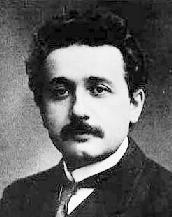 Special
Relativity: 1905 Special
Relativity: 1905
In 1905 Einstein entered for publication
in the monthly journal, Annalen der Physik, a number of articles
relating molecular action to heat, light, and body mass. These were
the foundational pieces for his Special Theory of Relativity. Immediately
the genius in these works was recognized, and University of Zurich awarded
him the Ph.D. for his work.
Einstein left his work at the Patent
Office and took up teaching, eventually becoming a full professor at the
University of Prague. Then in 1912 he returned to Switzerland to
a teaching position at the Federal Polytechnique in Zurich.
World War One: Family Turmoil
The years leading up to World War One
(1914) were a time of great contentment for Einstein, his wife and his
two sons, Hans Albert and Edward.
But World War One intervened to upset
this serene picture. In the spring of 1914 the family moved to Berlin
where Einstein had accepted a position at the University of Berlin.
That summer his wife and sons left on vacation for Switzerland, but when
the war broke out in September, they were unable to return to Berlin.
The physical separation eventually evolved into an emotional separation--and
Einstein and his wife divorced.
The growing tragedy of the war led
Einstein to an ever more vocal pacifist position--which put Einstein quite
out of step with his very nationalistic, even militaristic, professorial
colleagues. Einstein was appalled by the ability of the supposedly
highly civilized European nations to rationalize the massive murderousness
of the war effort.
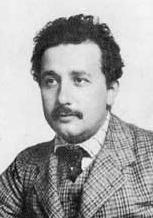 General
Relativity: 1916 General
Relativity: 1916
Nonetheless Einstein's work on a pet
project of his had been making headway and in 1916 he published an article
in Annalen der Physik entitled "The Foundation of the General Theory
of Relativity." Here he laid out the basic principles for a theory
that united a number of his special laws of relativity into a single General
Theory of Relativity.
In late 1918, with the end of the
"Great War," as World War One was then called, Einstein looked forward
to the rule of peace and reason within the West, and in Germany in particular.
In 1919, with a solar eclipse that
validated his theories about the action of light as it passed close to
a massive body, Einstein's fame became truly international in its extent.
A Growing Personal and Social Life
In that same year, 1919, he remarried--taking
for his wife his own widowed second cousin, Elsa, and fashioning a new
home with her and her two daughters.
Berlin in those days was a scene
of emotional-political turmoil, vented on the Communists and Jews who,
according to German ultra-nationalists, were supposedly conspiring to take
over the German nation. This was the beginning of very hard times
for Jews in Germany. It was at this time that Einstein, though a
religious agnostic, began to focus more on his own cultural Jewishness--by
taking up the Zionist cause. He even came to the United States in
1921 to raise money for the Palestine Foundation Fund, used to resettle
Jews in British-controlled Palestine (modern-day Israel).
Needless to say, he was much sought-after
as a lecturer on his new theories of physics and he found himself travelling
much over the next years, lecturing in Europe, America, and Asia.
In 1921 he was awarded the Nobel Prize for Physics.
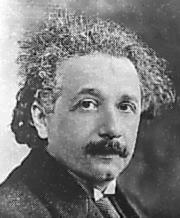 His
Quest for a Theory of Everything His
Quest for a Theory of Everything
Einstein was now focusing his thoughts
on the matter of how a simple principle stood behind the workings of the
whole universe. He was looking for a unified field theory--a theory
of "everything."
Unfortunately, the discovery of quantum
physicists (Bohr, Heisenberg and others) that there was a built-in indeterminacy
or uncertainty about the behavior of the fundamental particles of matter
(quanta) made Einstein's study of "everything" problematic at its
its very heart. Einstein himself refused to accept the uncertainty
principle as a final statement about the behavior of the universe's fundamental
material--and continued to look for a theory that could side-step this
uncertainty.
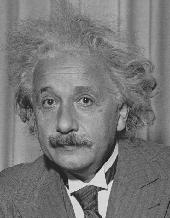 He
Leaves Germany for America He
Leaves Germany for America
In the meantime the very hard times
of the late 1920s and early 1930s touched even Einstein. The Zionist
program to resettle Jews in Palestine was getting unyielding oppostion
from the British authorities in Palestine--and violent opposition from
the Arabs living there. And in Germany, Hitler's Nazis were gaining
popularity by bashing Jews as national demons (along with international
capitalists, Communists, Socialists, Gypsies, homosexuals and a few other
categories of "undesireables"). Einstein's hope was also sinking
quickly that a new international legal order, embodied in the League of
Nations, would bring peace to the world. Increasingly the League
was proving itself unable to deal with the growing number of diplomatic
crises afflicting the world. Einstein grew bitter in his disappointment
over this failure.
In 1933, with Hitler's appointment
as Chancellor of Germany, Einstein renounced his German citizenship and
left the country. His mood now changed from one of pacifism to adamant
opposition to the Nazi regime, even calling on Europe to arm itself against
Hitler.
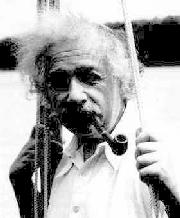 He
soon thereafter (October 1933) came to Princeton, New Jersey, to become
part of the faculty of the new graduate Institute for Advanced Study.
Here he lived quietly and routinely with his wife (until her death in 1936)--rarely
leaving Princeton over the years. Eventually he became an American citizen. He
soon thereafter (October 1933) came to Princeton, New Jersey, to become
part of the faculty of the new graduate Institute for Advanced Study.
Here he lived quietly and routinely with his wife (until her death in 1936)--rarely
leaving Princeton over the years. Eventually he became an American citizen.
World War Two and the Bomb
As war clouds gathered in Europe (1939)
Einstein was informed by his friend Niels Bohr that in accordance with
Einstein's theories, the uranium atom had been split, giving off a small
amount of its mass in the form of energy. This pointed to the thought
that this process could be--and most probably would be--controlled to produce
a bomb of catastrophic proportions. The question was--who would be
the first to achieve this goal: Germany or its enemies? Einstein
himself decided to write President Roosevelt to make him aware of the critical
challenge that nuclear power posed--and the need to develop atomic weaponry
before the Germans did. Thus was born the idea of the Manhattan Project.
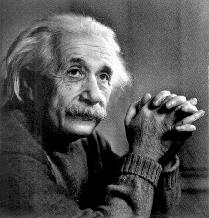 Einstein
himself was not part of the Manhattan Project in Los Alamos, New Mexico,
where America's atomic bombs were developed during the war years.
Nonetheless his own hand in developing the theoretical foundations underpinning
the nuclear age was quite evident to everyone. However, at war's
end, the pacifist in Einstein now reasserted himself, and Einstein's thoughts
now ran to the question of securing a world free from the terror of nuclear
arms--rather than to the challenge of staying ahead in the nuclear arms
race. Einstein
himself was not part of the Manhattan Project in Los Alamos, New Mexico,
where America's atomic bombs were developed during the war years.
Nonetheless his own hand in developing the theoretical foundations underpinning
the nuclear age was quite evident to everyone. However, at war's
end, the pacifist in Einstein now reasserted himself, and Einstein's thoughts
now ran to the question of securing a world free from the terror of nuclear
arms--rather than to the challenge of staying ahead in the nuclear arms
race.
Einstein Moves to the Sidelines
In his later years he remained focused
on the quest for a unified field theory. In 1950 Einstein published
a paper on the subject. But most physicists remained unconvinced
that his theories, though carefully worked out mathematically, were valid.
And this growing sense of separation
from the mainstream of physics and mathematics remained with Einstein all
the way to his death in Princeton in April of 1955. | 





 Go
to the history section: The Emerging Realm of Quantum Mechanics
Go
to the history section: The Emerging Realm of Quantum Mechanics

 Miles
H. Hodges
Miles
H. Hodges